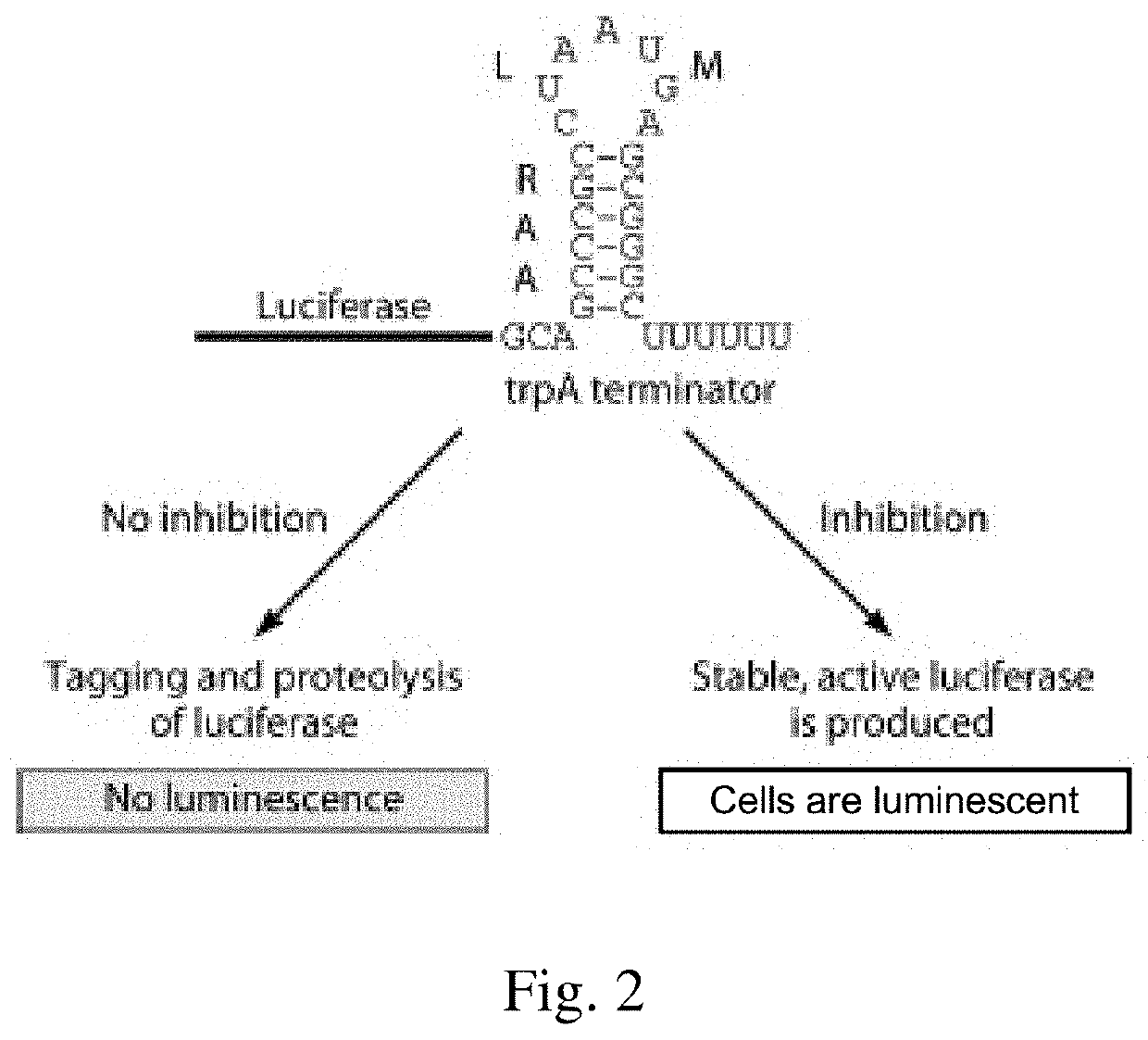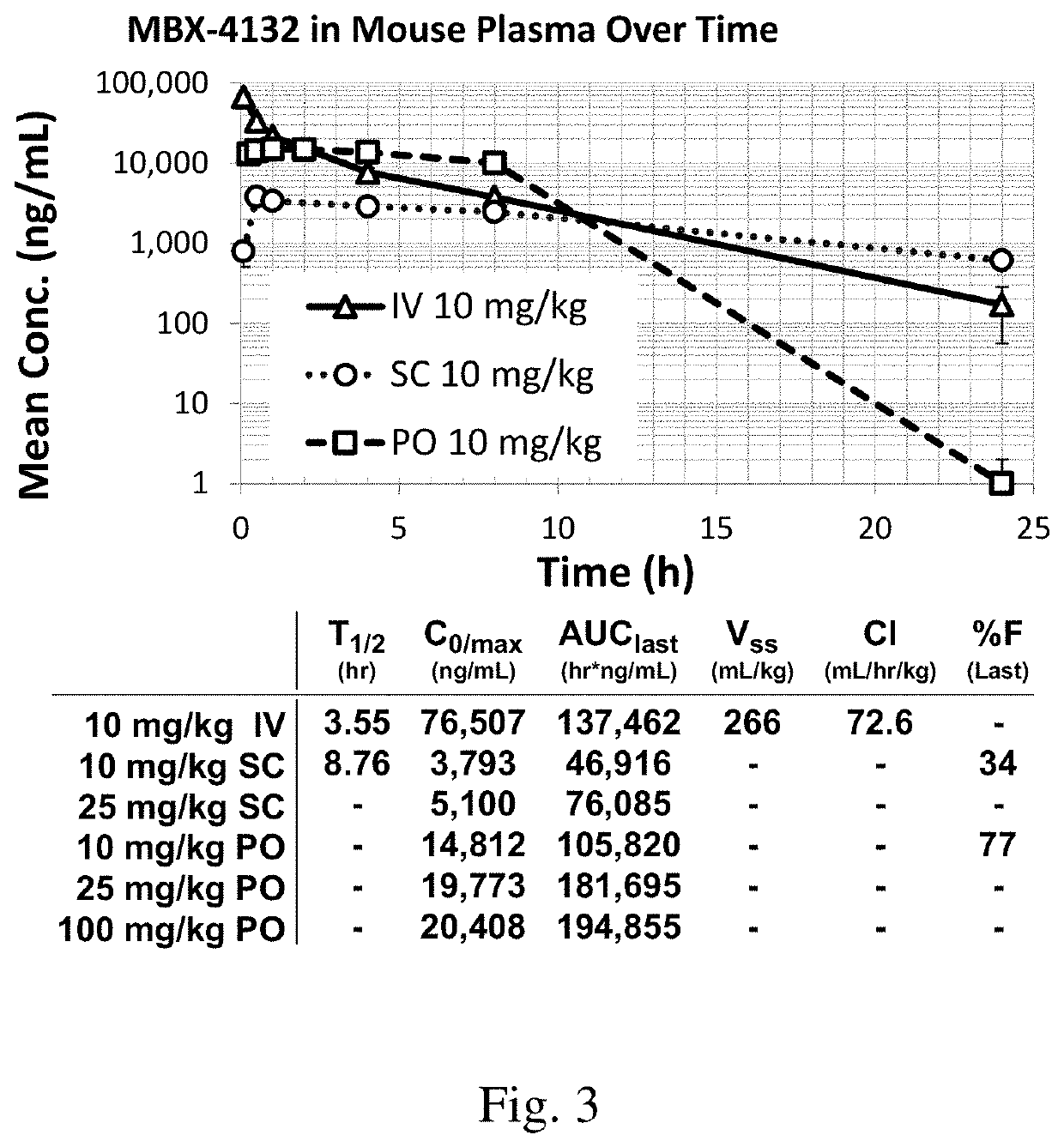Metabolically stable N-acylaminooxadiazoles useful as antibacterial agents
a technology of nacylaminooxadiazole and acylaminooxadiazole, which is applied in the field of metabolic stable nacylaminooxadiazole derivatives, can solve the problems of reducing treatment options, affecting the treatment effect, and increasing the number of multiple drug-resistant organisms (mdros) posing a serious threat to human health
- Summary
- Abstract
- Description
- Claims
- Application Information
AI Technical Summary
Benefits of technology
Problems solved by technology
Method used
Image
Examples
example 1
ization Data of Select Trans-Translation Inhibitors
[0191]Novel compounds were characterized by 1H NMR spectra at 300 MHz and LCMS with the m / z (typically M+1) using an electrospray ionization strategy. Table 1 (below) delineates representative data for select examples. Note: This data represents signals necessary to delineate basic structure and does not necessarily represent complete data either for all protons or coupling interactions in the proton NMR spectra or all mass signals in the mass spectroscopy experiment.
[0192]
TABLE 1Potency of Select trans-Translation InhibitorsCmpd No.m / z foundMBX-1H NMR Spectrum (solvent)by LCMS (M + x)4132(DMSO): 7.98-7.94 (m, 2H), 7.46-7.40 (m, 2H), 7.19 (s, 4H), 4.69339.0(s, 2H), 3.75 (t, 2H), 2.85 (t, 2H) (M + 1)4198 (CDCl3): 7.97-7.93 (m, 2H), 7.26-7.18 (m, 3H + CHCl3), 3.92-334.03.52 (m, 8H), 2.17 (s, 3H)(M + 1)4199(CDCl3 + MeOD): 8.04-7.93 (m, 2H), 7.25-7.13 (m, 2H), 4.58 (br t, 346.11H), 3.59-3.16 (m, 7H), 2.92-2.70 (m, 2H), 1.92-1.79 (m, 6H)...
example 2
r Evaluating Trans-Translation Inhibitor Properties
[0193]A number of analogs were synthesized as set forth herein, and their trans-translation inhibitory properties were evaluated according to the following assays.
i. High Throughput Luciferase-trpAT-Based Reporter Assay
[0194]The reporter contains a gene encoding luciferase with a strong transcriptional terminator inserted before the stop codon, such that transcription results in a nonstop mRNA. E. coli cells containing the reporter were screened in high-throughput format to identify compounds that inhibit trans-translation. When no inhibitor is present, translation of the nonstop mRNA results in trans-translation followed by proteolysis of luciferase, and cells produce no luminescence. Conversely, active luciferase is produced when a trans-translation inhibitor is present, resulting in luminescence. (See, FIG. 2.)
ii. In Vitro Antibacterial Activity (MIC)
[0195]To evaluate the antibacterial activity of the analogs, their minimal inhib...
example 3
rial Activity of Select Trans-Translation Inhibitory Compounds
[0210]A number of compounds of Formula I and Formula II were chosen for an analysis of their potency against a broad spectrum of both Gram-positive and Gram-negative bacterial species in an E. coli ΔtolC assay. The results are shown in Table 2 below.
[0211]
TABLE 2Antibacterial efficacy (MIC μg / mL) against various bacterial pathogensCompound No. MBX−Gram (+)bacterialstrains353541324237428542884292429343304331433243454347S. aureus0.993.172.350.67(MRSA-1234547263,Cip-res)MRSA-10940.993.172.352.525.680.750.722.033.155.0019.532.23(MDR)S. aureus0.994.232.350.95(ATCC 35556,spec, kan-res)S. aureus0.993.172.961.17NRS-77(spec-res)S. aureus0.994.232.351.19WTBF-19(MSSA.osteomyelitisisolate)S. aureus1.496.342.356.347.161.231.15≥324.457.0727.6>35ATCC 25923(MSSA.osteomyelitisisolate)MRSA USA0.881.062.100.632.010.300.291.01300 (BAA-1717MRSA N3151.486.344.701.36NRS-70S. pneumoniae33.84.704.774.5949619M. pneumoniae>33.818.819.118.415531B. a...
PUM
| Property | Measurement | Unit |
|---|---|---|
| particle size | aaaaa | aaaaa |
| total volume | aaaaa | aaaaa |
| aromatic | aaaaa | aaaaa |
Abstract
Description
Claims
Application Information
 Login to View More
Login to View More - R&D
- Intellectual Property
- Life Sciences
- Materials
- Tech Scout
- Unparalleled Data Quality
- Higher Quality Content
- 60% Fewer Hallucinations
Browse by: Latest US Patents, China's latest patents, Technical Efficacy Thesaurus, Application Domain, Technology Topic, Popular Technical Reports.
© 2025 PatSnap. All rights reserved.Legal|Privacy policy|Modern Slavery Act Transparency Statement|Sitemap|About US| Contact US: help@patsnap.com



